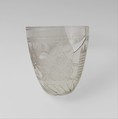Glass beaker with victorious charioteer
Colorless with olive green tinge.
Vertical, uneven rim; body tapering downwards with slight convex curving side; rounded bottom.
Below rim, a pair of conjoining horizontal wheel-cut grooves; another pair of grooves near top of body framing a wheel-abraded Greek inscription; below this, a wide band decorated with a quadriga racing to left towards two figures holding victory palms; behind the chariot is a building with three spires or gabled turrets and another palm; below the ground line, a band of wheel-abraded close-set diagonal lines and around the bottom another band of widely-spaced diagonal lines. In two places errors have been made in carving the inscription. The Greek inscription provides the name of the charioteer, Eutych[ides], and his horses; three of the four are still legible: Arethousios (named after a famous, fast-flowing stream), Neilos (the River Nile), and Pyripnous (Fire-breather).
Broken and restored from fragments with more than half missing; few bubbles; little weathering.
Unlike glassware decorated with gladiators (such as the mold-blown cup 81.10.245), on which only the combatants are shown, the glass cups and beakers that depict chariot racing usually include some features of the setting in the circus. The three spires here may represent part of the spina (the barrier that ran down the middle of the race track).
The cut decoration commemorates a victorious charioteer in his quadriga. His name, Eutych[ides], is inscribed in Greek. His horses are also named, and three of the four are still legible: Arethousios (named after a famous, fast-flowing stream), Neilos (the River Nile), and Pyripnous (Fire-breather).
Due to rights restrictions, this image cannot be enlarged, viewed at full screen, or downloaded.
This artwork is meant to be viewed from right to left. Scroll left to view more.



